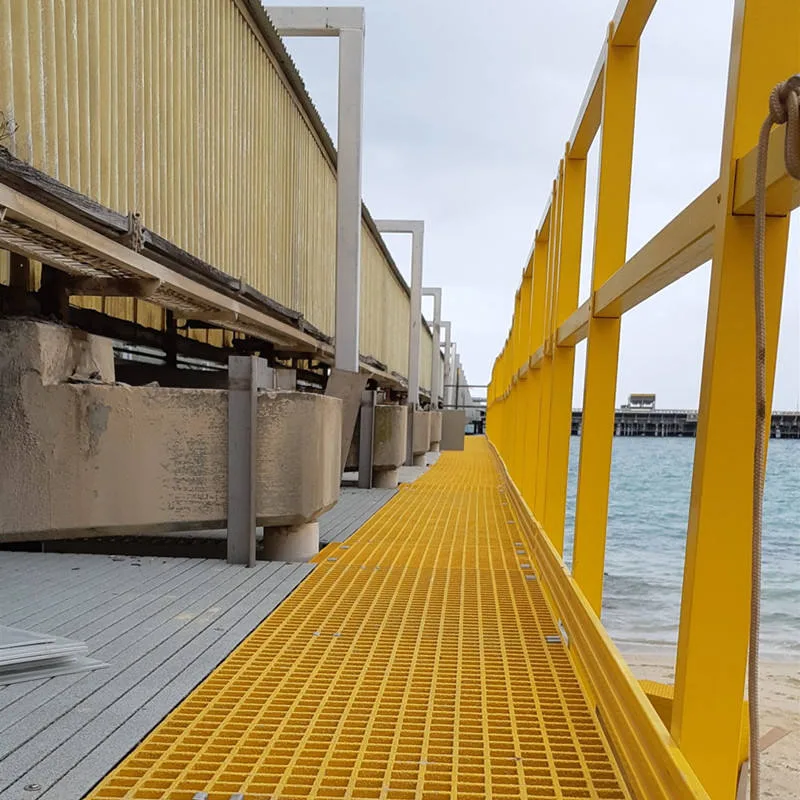Introduction
Fiberglass FRP (Fiber-Reinforced Plastic) grating has become a preferred choice across various industrial sectors, thanks to its impressive combination of durability, safety, and cost-effectiveness. Unlike traditional materials like steel or wood, fiberglass FRP grating is engineered to withstand harsh environments while offering numerous practical benefits.
In this article, we will explore the top five advantages of fiberglass FRP grating and understand why it has become an indispensable material for industrial applications.

fiberglass frp grating
What is Fiberglass FRP Grating?
Fiberglass FRP grating is a composite material made from a matrix of resin reinforced with fiberglass. This combination results in a lightweight yet robust material with excellent resistance to corrosion, chemicals, and environmental stressors.
Unlike traditional materials such as steel, fiberglass FRP grating is non-corrosive, non-conductive, and requires minimal maintenance, making it an ideal solution for environments exposed to moisture, chemicals, or electricity.
Top 5 Advantages of Fiberglass FRP Grating
1. Corrosion Resistance
One of the standout features of fiberglass FRP grating is its resistance to corrosion. Unlike steel or aluminum, which can rust or deteriorate in harsh environments, FRP grating remains unaffected by moisture, chemicals, and saltwater.
- Example: In wastewater treatment plants, where exposure to corrosive substances is constant, FRP grating outperforms traditional materials by maintaining its structural integrity over time.
2. Lightweight and Easy to Install
Fiberglass FRP grating is significantly lighter than metal alternatives, making it easier to transport and install. This lightweight nature not only reduces labor costs but also minimizes the need for heavy lifting equipment.
- Example: Construction projects benefit from shorter installation times, allowing teams to meet deadlines efficiently.
3. High Strength and Durability
Despite its lightweight composition, fiberglass FRP grating offers exceptional strength. Its load-bearing capacity is comparable to steel, and its strength-to-weight ratio often surpasses traditional materials.
- Example: In industrial walkways and platforms, FRP grating can support heavy equipment without bending or breaking, ensuring long-term reliability.
4. Non-Conductive and Safe
Safety is a critical concern in industrial settings, and FRP grating excels in this area. Its non-conductive nature makes it an excellent choice for environments with electrical hazards. Additionally, it often features anti-slip surfaces for enhanced worker safety.
- Example: Electrical substations use FRP grating to prevent accidental shocks, creating a safer workspace for employees.
5. Low Maintenance Requirements
Fiberglass FRP grating is designed to last with minimal upkeep. Unlike steel, which requires regular painting and rust prevention, FRP grating retains its properties without the need for frequent maintenance.
- Example: In marine environments, FRP grating resists saltwater corrosion and requires only periodic cleaning, saving time and costs.
Applications of Fiberglass FRP Grating
Fiberglass FRP grating is versatile and finds applications across various industries:
- Marine: Decking, walkways, and docks.
- Chemical Processing: Corrosion-resistant flooring and platforms.
- Construction: Drain covers, stair treads, and scaffolding.
- Food Processing: Hygienic and non-corrosive flooring solutions.
These applications highlight its adaptability and performance in demanding conditions.
Why Choose Fiberglass FRP Grating Over Traditional Materials?
When compared to steel, aluminum, or wood, fiberglass FRP grating offers a clear edge in terms of durability, safety, and cost-effectiveness. Its ability to withstand harsh environments without compromising performance makes it a long-term investment. Moreover, its lightweight and maintenance-free properties contribute to overall project efficiency and reduced lifecycle costs.
Conclusion
Fiberglass FRP grating is a game-changer for industries seeking reliable, safe, and cost-efficient solutions. Its corrosion resistance, lightweight construction, high strength, safety features, and low maintenance requirements make it the go-to material for various applications.
If you’re considering upgrading your industrial infrastructure, fiberglass FRP grating is a smart and sustainable choice. Explore the options available today and take the first step toward improving your operations.




























